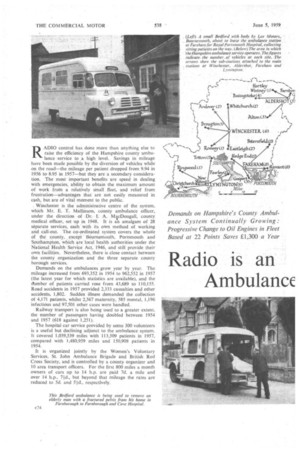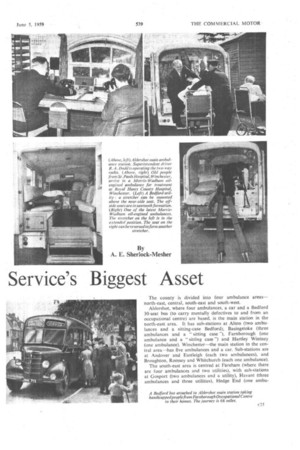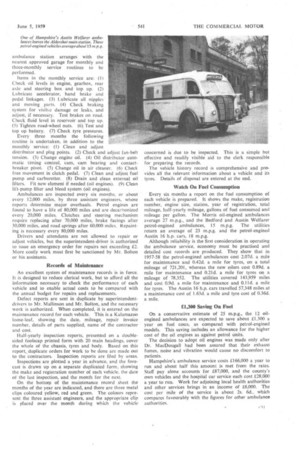Radio is an Ambulana Service's Biggest Asset
Page 66

Page 67

Page 68

Page 73

If you've noticed an error in this article please click here to report it so we can fix it.
By A. E. Shedock-Mesher
RADIO control has done more than anything else to raise the efficiency of the Hampshire county ambulance service to a high: level.. Savings in mileage have been made possible by the diversion of vehicles while on the road—the mileage per patient dropped from 9.94 in 1956 to 8.95 in 1957—but they are a secondary consideration.. The mostimportant benefits are speed in dealing with emergencies, ability to obtain -the maximum amount of work from a relatively Small fleet, and relief from frustration—advantages that are not easily measured in cash, but. are of vital moment to the public.
. Winchester is the administrative centre of the system. which Mr. E.T. Mallinson, county ambulance officer, under the direction of -Dr. I: A. -MacDougall, county Medical officer, set up in 1948. It is an amalgam of 28 separate services, each with its own method of working and call-Out. The .0-ordinated system covers the whole of the county, except BOurnemouth, Portsmouth and Southampton, which are'local.health authorities under the National Health Service Act, 1946, and still provide their own facilities. Nevertheless, there is close contact between the county. organization and the three separate county borough services.
Demands on the ambulances grow year by year. The mileage increased from 693,352 in 1954 to 962,552 in 1957 (the latest year for which statistics are available), and the 'lumber of patients carried rose from 43,689 to 110,155. Road accidents in 1957 provided 2,333 casualties and other accidents, 1,802. Sudden illness demanded the collection of 4,171 patients, whilst 2,567 maternity, 585 mental, 1,196 infectious and 97,501 other cases were handled.
Railway transport is also being used to a greater extent, the -number of passengers having doubled between 1954 and 1957 (618 against 1,251).
The hospital car service provided by some 300 volunteers is a useful but declining adjunct to the ambulance system, It covered 1,039,539 miles with 113,509 patients in 1957, compared with 1,480,959 miles and 150,908 patients in 1954.
It is organized jointly by the Women's Voluntary Services, St. John Ambulance Brigade and British Red Cross Society, and is controlled by a county organizer and 10 area transport officers. For the first 800 miles a month owners of cars up to 14 h.p. are paid 7d, a mile and over 14 h.p., 71d., but beyond that mileage the rates are reduced to 5d. and 51.d., respectively. The county is divided into four ambulance areas— north-east, central, south-east and south-west.
Aldershot, where four ambulances, a car and a Bedford 30-seat bus (to carry mentally defectives to and from an occupational centre) are based, is the main station in the north-east area. It has sub-stations at Alton (two ambulances and a sitting-case Bedford), Basingstoke (three ambulances and a "sitting case Farnborough (one ambulance and a "sitting case ") and Hartley Wintney (one ambulance). Winchester—the main station in the central area—has five ambulances and a car. Sub-stations are at Andover and Eastleigh (each two ambulances), and Broughton, Romsey and Whitchurch (each one ambulance). The south-east area is centred at Fareham (where there are four ambulances and two utilities), with sub-stations at Gosport (two ambulances and a utility), Havant (three ambulances and three utilities), Hedge End (one ambu lance) and Petersfield (one ambulance and a utility). Lymington, with four ambulances and a car, is the main station of the south-west area. Sub-stations are at Christchurch (two ambulances and a sitting-case vehicle) and Fawley, Ringwood, New Milton and Totton (each with one ambulance). At each of the main stations one ambulance is regarded as a spare. One of the ambulances at Winchester is an area spare and another is a county spare.
Each area is self-contained, but is not watertight, and is controlled by a superintendent-driver. A head driver is in charge of each of the six large sub-stations. There are 104 whole-time ambulance driver-attendants and four parttime attendants. Each of the main stations has a full-time clerk-telephonist. All the operational staff are fully qualified in first-aid and attend annual refresher courses.
Main stations are manned by drivers working shifts from 6 a.m. until 2 p.m., 2 p.m. until 10 p.m. and 10 p.m. until 6 a.m., with a superimposed day shift from 9 a.m. to 6 p.m. to provide the maximum number of drivers during peak hours. Normally, when they are on duty (from 8 a.m. until 5 p.m., Monday to Friday, and from 8 a.m. to 1 p.m. on Saturday) the senior head drivers and clerk-telephonists look after the three telephones and radio system and control the movement of vehicles within their division.
At other times their workis taken over by the driver-attendants on duty, who receive additional pay . for the extra responsibility. Members of the mainstation staffs also do stand-by duty at home during the week-ends and at night,
and are available for immediate summons by telephone.
Sub-stations are manned from 9 a.m. until 6 p.m. from Monday to Friday, and from 9 a.m. until 1 p.m. on Saturday. At other times some of the drivers stand by at home, taking their ambulances with them if they live far.
Orders Centralized
All requests for ambulances or cars are sent to the main stations, and work which cannot be done by the ambulances is passed to the hospital car service. Ordering authorities are asked to give as much notice as possible, so that journeys can be co-ordinated, and, in any event, not later than midday before the day transport is required.
In an emergency, anyone making a telephone call in. the: proper manner will be connected at once with the nearest main ambulance station. Ambulance crews at .Aldershot,• who have been specially instructed, in the work, handle all confirmed or suspected cases of sniallpox.1
Each of the 44 ambulances is quipped with Pye twoway radio apparatus and is in constant touch with the main station to which it is attached. Radio communica tion has proved invaluable. As Dr. MacDougall said in his report in 1957: "The old frustration of knowing that an ambulance was in the vicinity of an emergency, but that there was no means of contacting the crew, is gone for ever."
Moreover, the reverse—the arrival of several vehicles at one incident—no longer occurs. Another advantage is that the driver and the main-station staff can together check the time of arrival of an ambulance.
A radio transmitter stands on high ground near each r:26 main station and is remotely controlled through land lines. Each ambulance division and the vehicles attached to it has a colour code, which is used in conjunction with the call-sign " Hantsam." Vehicles are also numbered. A call to " Hantsam Blue 3" would be known to all concerned as to ambulance No. 3 in the north-east area. Main stations identify themselves as "Control" (" Hantsam White Control," for instance, denotes Fareham), and Winchester headquarters is "Master Control."
A monitor receiver at each of the transmitter stations enables each to listen to the other three. The remotecontrol unit at the Castle, Winchester, the county headquarters, is coupled to the Winchester transmitter.
Most of the ambulances, which have a life of about 10 years, are based on a Bedford 30-cwt. chassis, with a few Austin Welfarers, but the policy is now to standardize on Morris L.C.0.5 models with B.M.C. 3.4-litre oil engines and Wadham bodies. Twelve are now in service and set a high standard of construction and comfort. They cost about £1,780 each.
The bodywork is designed to the county officers' specification and can be converted from two berths to four berths in about three minutes. Equipment includes a special folding chair. A recent innovation is a plastics curtain suspended from the roof down the centre of the ambulance to give patients greater privacy. All windows have upward-lifting blinds. Another appreciated facility is a bell-push on the end of a cable, which a patient can hold while on the stretcher and signal the driver to stop, if necessary. Hardec lining panels of a pale blue and cream mottled design tone with dark blue Ruberoid floor covering and white leather upholstery.
Lee Motors, Bournemouth, build the utility bodies to the council's specification, on Bedford CA chassis. They are designed primarily for sating cases, but can readily be converted for stretcher work by folding up the longitudinal seat on the near side. On the off side, three seats in sawtooth formation provide ample legroom and space for handling infirm passengers. The vehicles cost.ahout.£1,031:1 each and are estimated to last six to seven years.
Maintenance is the responsibility of Mr. J. C. Bolton, county mechanical engineer, whose department is under the wgis of Mr. H. N. Jenner, county surveyor. Ambulances are a small part of the fleet of 464 vehicles and 822 items of plant and equipment which the mechanical engineer has to keep in good condition.
All the work is contracted out under rigid supervision at tender prices. The superintendent-driver at each main ambulance station arranges with the nearest approved garage for monthly and three-monthly service routines to be performed.
Items in the monthly service are: (1) Check oil levels in engine, gearbox, rear axle and steering box and top up, (2) Lubricate accelerator, hand brake and pedal linkages. (3) Lubricate all nipples and moving parts. (4) Check braking system for visib.e damage or leaks, and adjust, if necessary. Test brakes on road. Check fluid level in reservoir and top up. (5) Tighten road-wheel nuts. (6). Test and top up battery. (7) Check tyre Pressures.
Every three months the following routine is undertaken, in addition to the monthly service: (1) Clean and adjust distributor and plug points. (2) Check and adjust fan-belt tension. (3) Change engine oil. (4) Oil distributor automatic timing control, cam, cam bearing and contactbreaker pivot. (5) Change oil in air cleaner. (6) Check tree movement in clutch pedal. .(7) Clean and adjust fuel pump and carburetter. (8) Drain and clean external oil filters. Fit new element if needed (oil engines). (9) Clean lift-pump filter and bleed system (oil engines).
Ambulances are inspected every six months, or about every 12,000 miles, by three assistant engineers, whose reports determine major overhauls. Petrol engines are found to have a life of 80,000 miles and are decarbonized every 20,000 miles. Clutches and steering mechanism require replacing after 70,000 miles, brake facings after 30,000 miles, and road springs after 60,000 miles. Repainting is necessary every 80,000 miles.
Drivers and attendants are not allowed to repair or adjust. vehicles, but the superintendent-driver is authorized to issue an emergency order for repairs not exceeding £2. More costly work must first be sanctioned by Mr. Bolton or his assistants.
Records of Maintenance
An excellent system of maintenance records is in force. It is designed to reduce clerical work, but to afford all the information necessary to check the performance of each vehicle and to enable actual costs to be compared with the annual budget for repairs and replacements.
Defect reports are sent in duplicate by superintendentdrivers to Mr. Mallinson and Mr. Bolton, and the necessary work is authorized. When completed, it is entered on the maintenance record for each vehicle. This is a Kalamazoo loose-leaf, showing the date, mileage, repair invoice number, details of parts supplied, name of the contractor and cost.
Half-yearly inspection reports, presented on a doublesided foolscap printed form with 20 main headings, cover the whole of the chassis, tyres and body. Based on this report, duplicate orders for work to be done are made out to the contractors. Inspection reports are filed by areas.
Inspections are plotted a year in advance, and the forecast is drawn up on a separate duplicated form, showing the make and registration number of each vehicle, the date of the last inspection, and the month for the next.
On the bottom of the maintenance record sheet the months of the year are indicated, and there are three metal clips coloured yellow, red and green. The colours represent the three assistant engineers, and the appropriate clip is placed over the month during which the vehicle concerned is due to be inspected. This is a simple but effective and readily visible aid to the clerk responsible for preparing the records.
The vehicle history record is comprehensive and provides all the relevant information about a vehicle And its tyres. Details of disposal are entered at the end.
Watch On Fuel Consumption
Every six months a report on the fuel consumption of each vehicle is prepared. It shows the make, registration number, engine size, station, year of registration, total mileage, half-yearly mileage, gallons of fuel consumed and mileage per gallon. The Morris oil-erigined ambulances average 27 m.p.g., and the 13edforcl and Austin Welfarer petrol-engined ambulances, 15 m.p.g. The utilities return an average of 23 m.p.g. and the petrol-engined Austin 16 h.p. cars, 18 m.p.g.
Although reliability is the first consideration in operating the ambulance service, economy must be practised and detailed cost records are produced. They show that in 1957-58 the petrol-engined ambulances cost 2.07d. a mile for maintenance and 0.42d. a mile for tyres, on a total mileage of 721,201, whereas the new oilers cost 0.89d. a mile for maintenance and 0.21d. a mile for tyres on a mileage of 78,352. The utilities covered 143,959 miles and cost 0.9d. a mile for maintenance and 0.1Id. a mile for tyres. The Austin 16 h.p. cars travelled 57,348 miles at a maintenance cost of 1.63d. a mile and tyre cost of 0.36d. a mile.
ELMO Saving On Fuel On a conservative estimate of 25 m.p.g., the 12 oilengined ambulances are expected to save about £1,300 a year on fuel costs; as compared with petrol-engined models. This saving includes an allowance for the higher cost of the oil engines as against petrol Units.
The decision to adopt oil engines was made only after Dr. MacDougall had been assured that their exhaust fumes, noise and vibration would cause no discomfort to patients.
Hampshire's ambulance service costs £166,000 a year to run and about half this amount is met from the rates. Staff pay alone accounts for £87,000, and the county's own vehicles and the hospital car service each cost £28,000 a year to run. Work for adjoining local health authorities and other services brings in an income of 16,000. The cost per mile of the service is about 2s. 6d., which compares favourably with the figures for other ambulance authorities.




































































































































